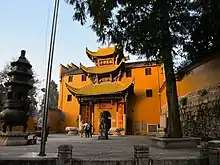Zhiyuan Temple (Mount Jiuhua)
Zhiyuan Temple (simplified Chinese: 祗园寺; traditional Chinese: 祗園寺; pinyin: Zhīyuán Sì) is a Buddhist temple located on Mount Jiuhua, in Qingyang County, Anhui, China.[1] Alongside Ganlu Temple, Baisui Palace and Dongyan Chan Temple are honoured as the "Four Buddhist Temple on Mount Jiuhua".
| Zhiyuan Temple | |
|---|---|
祗园寺 | |
 The Mahavira Hall at Zhiyuan Temple | |
| Religion | |
| Affiliation | Buddhism |
| Location | |
| Location | Mount Jiuhua, Qingyang County, Anhui |
| Country | China |
| Geographic coordinates | 30°29′31″N 117°48′15″E |
| Architecture | |
| Style | Chinese architecture |
| Date established | Jiajing period (1522–1566) |
Name
The name of the temple is cited from Buddhist Stories, which says that Sakyamuni lived in a placed named "Zhiyuan" (祗园) or "Guduyuan" (孤独园) for over twenty years.[2]
History
Zhiyuan Temple was first built in the Jiajing period (1522–1566) of the Ming dynasty (1368–1644), and went through many changes and repairs through the following Qing dynasty (1644–1911). Most of the present structures in the temple were repaired or built in the Qing dynasty.[2] In 1841, during the reign of Daoguang Emperor (1840–1850) in the Qing dynasty, abbot Longshan (隆山) died. His body became a mummy but was destroyed by the Red Guards in the Cultural Revolution.[3]
The temple was originally named "Zhishu'an" (祗树庵) and renamed "Zhiyuan Temple" after the extension under the leadership of monk Dagen (大根).[3]
Zhiyuan Temple has been designated as a National Key Buddhist Temple in Han Chinese Area by the State Council of China in 1983. On October 28, 2014, it was classified as a municipal cultural unit by the local government.
Architecture

The existing main buildings include the Shanmen, Four Heavenly Kings Hall, Mahavira Hall, Lingguan Hall, Maitreya Hall, Reception Hall, Dining Hall, and Abbot's Room.[2][4]
Shanmen
The Shanmen is flush threefold story gable roof style (三层硬山顶). Statues of Heng and Ha and Lord Lingguan (灵官) are enshrined in the hall.[5]
Four Heavenly Kings Hall
The Four Heavenly Kings Hall has a double-eave gable and hip roof (重檐歇山顶). Statues of Four Heavenly Kings are housed in the hall.[5]
Mahavira Hall
The Mahavira Hall is the main and third hall in the temple. It has a double-eave gable and hip roof (重檐歇山顶) covered with yellow glazed tiles, which symbolize a high level in architecture because yellow was the symbol of the royal family.[3]
The hall houses three gilded copper statues of Three-Life Buddha, namely Sakyamuni, Amitabha and Bhaisajyaguru. They have an average height of about 7-metre (23 ft), which is the highest statues on Mount Jiuhua. The statue of Guanyin is placed at the back of the three statues. The statues of Eighteen Arhats stand on both sides of the hall.[3]
Cultural relics
The temple's kitchen keeps seven bronze cauldrons, the largest having 173-centimetre (68 in) in diameter and 56-centimetre (22 in) in height, which are known as "thousand monks cauldrons" (千僧灶) for its capacity of cooking 200-kilogram (440 lb) of rice each time.[6]
The Buddhist Texts Library has the only Tripitaka (龙藏) collection in Chinese printed by the Qing imperial court and 1,669 other Tripitaka books.[6]
References
- 祗园寺 [Zhiyuan Temple]. jhsfojiao.com (in Chinese). 2016-10-12.
- Wang Jia (2012), p. 118.
- Zhang Yuhuan (2012), p. 145.
- 九华山的佛教建筑艺术(一) [Architectural Art of Buddhism on Mount Jiuhua]. iFeng (in Chinese). 2010-06-04.
- Zhang Yuhuan (2012), p. 144.
- Wang Jia (2012), p. 119.
Bibliography
- Wang Jia (2012). "Mount Jiuhua: Zhiyuan Monastery". Famous Mountains in China (in English and Chinese). Huangshan, Anhui: Huangshan Publishing House. ISBN 978-7-5461-2704-0.
- Zhang Yuhuan (2012). "Legend of Living Buddha Longshan: Zhiyuan Temple on Mount Jiuhua" 《隆山和尚不服肉身的传说:九华山祗园寺》. 《图解中国著名佛教寺院》 [Illustration of Famous Buddhist Temples in China] (in Chinese). Beijing: Contemporary China Publishing House. ISBN 978-7-5154-0135-5.